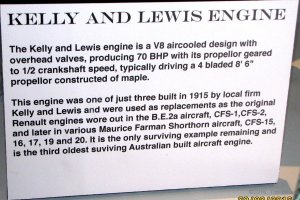
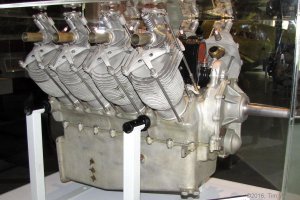
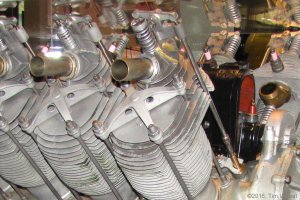
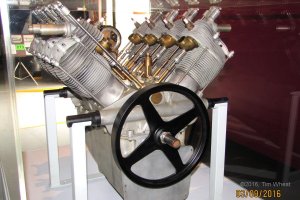
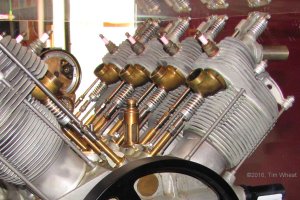

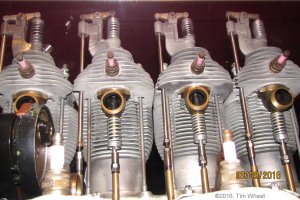
Australian National Aviation Museum
Rare Engine Photos
by Tim Wheat
 |
 |
 |
 |
| Kelley & Lewis V-8 | Kelley & Lewis V-8 | Kelley & Lewis V-8 | Kelley & Lewis V-8 |  |
 |
 |
| Kelley & Lewis V-8 | Kelley & Lewis V-8 | Kelley & Lewis V-8 |
More About the Kelley & Lewis V-8 (courtesy of the ANAM web site)
Kelly & Lewis engines were the products of Kelly & Lewis Ltd, a Melbourne based engineering company formed in 1899 through partnership of Edward Lewis and George Kelly. Operating from Melbourne premises in Little Bourke Street opposite the old works of Wright and Edwards (which they acquired later) the partners gained a reputation of excellence of their products.
The firm's development was aided by the demand from West Australian deep-lead goldfields for steam-driven winders, condensing plants and pumps. Kelly & Lewis constructed plant for zinc recovery by flotation and in 1910 began producing internal combustion engines.
Wartime production included the manufacture of three aircraft engines for the Australian Flying Corps for the B.E.-2a aircraft of the Central Flying School at Point Cook.
In 1913 the firm became a proprietary company with a capital of £50,000 and after Kelly died in 1919 Lewis was the sole managing director. Many men spent their whole working lives at Kelly & Lewis, with sons following fathers. Edward Lewis's habit was to visit each department at least once a day and his 'system of mental arithmetic and shirt cuff memoranda' enabled him to give instant summaries of the work in hand. Construction of a large foundry at Springvale began in 1921 and contracts after this time included extensions to the Yallourn power house and sluice gates for the Hume weir.
Kelly & Lewis Ltd went on to build many petrol and diesel stationary engines for farm and industrial use and merged with the Thompson Engineering and Pipe Company of Castlemaine in 1987, and continues to trade today as Thompsons, Kelly & Lewis Pty Ltd (a subsidiary of BTR Nylex Ltd).
On 16 February 1915 the Minister for Defence, Senator George Pearce announced that the Defence Department would proceed with the building of military aircraft in Australia, that 6 Renault engines were required, and engineering firms could communicate with the Department for particulars. On 28 August 1915 a 70hp engine patterned on the air cooled Renault V8 was completed by Tarrant Motors Pty Ltd Melbourne and bench tested, and later taken to Point Cook for installation in a B.E.2a. Tarrant had recieved orders for three engines while three other Renault engines were ordered from Kelly and Lewis.
In 1915 Kelly and Lewis constructed their three V8 aero engines at their factory in Melbourne, these were also based on the 70 HP Renault engines already fitted to CFS-1 and CFS-2, the two Royal Aircraft Factory B.E. 2a aircraft delivered to Point Cook in February 1914.
Despite the stated intention to build military aircraft in Australia, only one aircraft was built at Point Cook during WW1, that being Boxkite CFS-8, fitted with a 50HP Gnome rotary engine, and first flown in August 1915.
It would seem the six local V8 engines were instead used as replacements as the Renaults wore out in the B.E.2a aircraft CFS-1 and CFS-2, and later in various Maurice Farman Shorthorn aircraft, CFS-15, 16, 17, 19 and 20, which were similarly powered with 70HP Renault engines.
The Kelly and Lewis engine was a V eight aircooled design with overhead valves, producing 70 BHP with its propellor geared to 1/2 crankshaft speed, typically driving a 4 bladed 8' 6" propellor constructed of maple.
Our Kelly and Lewis engine is understood to have been the third example built for the AFC in 1915, but later supplied to George McKenzie Jnr of Rainbow Victoria at the end of the war, for use in his home-built aircraft known as the "Silver Wings" Biplane which he had constructed in 1919 or 1920. The engine was later returned to Kelly & Lewis around sometime between 1928 and 1930 before later being donated to the museum collection.
The McKenzie Silver Wings was a biplane of 30' span, with solid spars and wrought iron fittings, aircraft cable was not used, and on inspection by Captain F W Follett of the Civil Air Branch on 13 April 1921 it was determined a Certificate of Airworthiness could not be granted.
McKenzie conducted taxi tests on 21 October 1921 and had arranged R G Carey to test-fly the aircraft. Captain Whittingham of the British Imperial Oil Co was also present and attempted to fly the aircraft, taking off down wind, he succeeded in climbing steeply to 20 feet where the aircraft stalled, turned right and headed for some mallee bushes. Whittingham attempted to turn away and land, but crashed with the propellor broken, airframe damaged and minor injuries to himself.
H C Brimstead, Controller of Civil Aviation, sought an explanation of the incident given Whittingham did not hold a pilot's licence, however the matter later lapsed through lack of evidence.
On 22 April 1926 the Silver Wings flew successfully for 5 minutes at Geelong in the hands of C D Pratt with McKenzie as passenger, and later flew two more flights with P J Pratt as passenger. On 23 April 1926 P J Pratt of the Aircraft Manufacturing & Supply Co of Australia wrote to the Civil Air Branch advising of the successful flights, including minor modifications, and sought registration of the aircraft. A reply was sent from the CAB on 6 May 1926 advising registration marks would be issued after the CAB was "satisfied it was reasonably safe for flights" and the aircraft's subsequent history is unknown, other than the engine being eventually returned to the manufacturer between 1928 and 1930.
The Kelly and Lewis V8 Engine built for the CFS B.E.-2a aircraft in 1915 and supplied to George McKenzie in 1919 is now on display at the Australian National Aviation Museum at Moorabbin, and the only surviving example of the type, and the third oldest surviving Australian built aircraft engine - after the 1910 Tilley used by Duigan and the 1911 Aubrey Locke Engine used by Marshall,both now residing in the collection of the Museum of Victoria